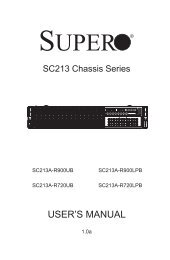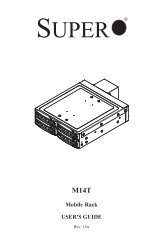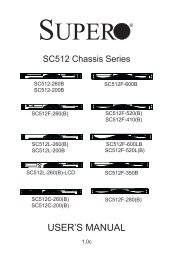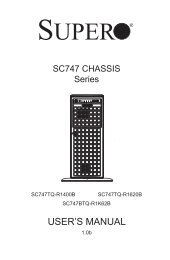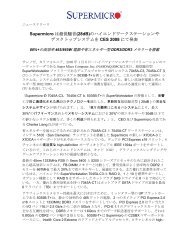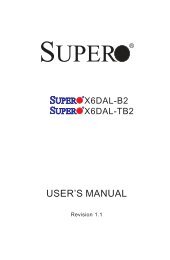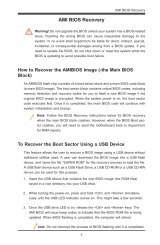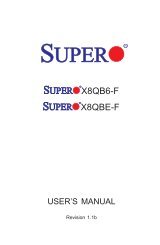X9DR3_i-LN4F+ 1.1.indb - Supermicro
X9DR3_i-LN4F+ 1.1.indb - Supermicro
X9DR3_i-LN4F+ 1.1.indb - Supermicro
You also want an ePaper? Increase the reach of your titles
YUMPU automatically turns print PDFs into web optimized ePapers that Google loves.
Chapter 4: AMI BIOS<br />
Serial Port 2 Attribute<br />
Use this feature to select the attribute for serial port 2. The options are SOL (Serial<br />
On LAN), and High Speed.<br />
Serial Port Console Redirection<br />
• COM 1/COM 2<br />
These two submenus allow the user to configure the following Console Redirection<br />
settings for a COM Port specified by the user.<br />
Console Redirection<br />
Select Enabled to use a COM Port selected by the user for Console Redirection.<br />
The options are Enabled and Disabled. The default setting for COM1 is Disabled,<br />
and for COM2/SOL is Enabled.<br />
Console Redirection Settings<br />
This feature allows the user to specify how the host computer will exchange data<br />
with the client computer, which is the remote computer used by the user.<br />
Terminal Type<br />
Use this feature to select the target terminal emulation type for Console Redirection.<br />
Select VT100 to use the ASCII Character set. Select VT100+ to add color<br />
and function key support. Select ANSI to use the Extended ASCII Character Set.<br />
Select VT-UTF8 to use UTF8 encoding to map Unicode characters into one or<br />
more bytes. The options are ANSI, VT100, VT100+, and VT-UTF8.<br />
Bits Per second<br />
Use this feature to set the transmission speed for a serial port used in Console<br />
Redirection. Make sure that the same speed is used in the host computer and<br />
the client computer. A lower transmission speed may be required for long and<br />
busy lines. The options are 9600, 19200, 57600 and 115200 (bits per second).<br />
Data Bits<br />
Use this feature to set the data transmission size for Console Redirection. The<br />
options are 7 Bits and 8 Bits.<br />
Parity<br />
A parity bit can be sent along with regular data bits to detect data transmission<br />
errors. Select Even if the parity bit is set to 0, and the number of 1's in data bits<br />
is even. Select Odd if the parity bit is set to 0, and the number of 1's in data bits<br />
is odd. Select None if you do not want to send a parity bit with your data bits<br />
4-19




